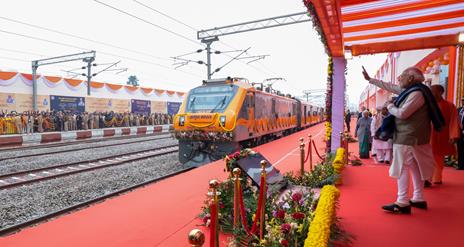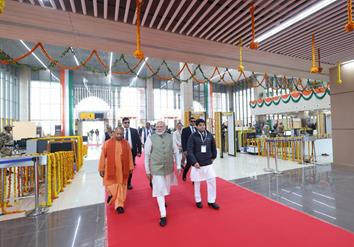Modernity Meets Heritage: PM Modi Unveils Maharishi Valmiki Airport and Ayodhya Dham Station
Ayodhya and its surrounding areas will benefit from more than Rs 11,100 crore development projects.
Prime Minister Narendra Modi inaugurated the Maharishi Valmiki International Airport at Ayodhya Dham, a project intertwining cultural reverence with contemporary advancement in an emblematic stride towards modernizing India’s transport infrastructure. This landmark event marks a significant development in the aviation sector and a symbolic fusion of India’s rich heritage with its ambitious modernization goals.
Dham, a project intertwining cultural reverence with contemporary advancement in an emblematic stride towards modernizing India’s transport infrastructure. This landmark event marks a significant development in the aviation sector and a symbolic fusion of India’s rich heritage with its ambitious modernization goals.
The newly christened Maharishi Valmiki International Airport, named after the revered sage and author of the epic Ramayana, is a testament to India’s commitment to honouring its cultural legacy while embracing the future. The airport’s design, featuring the architectural style of the upcoming Shri Ram Mandir, showcases India’s unique ability to blend tradition with modernity. The terminal building, adorned with local art, murals, and paintings depicting the life of Lord Ram, offers a glimpse into the country’s deep-rooted cultural narratives.
The inauguration of this airport is not merely about improved connectivity; it’s a narrative of cultural revival and national pride. With a capacity to handle 10 lakh passengers annually in its first phase, scaling up to 60 lakh post the second phase, the airport promises to be a crucial hub in facilitating tourism and economic growth in the region. Including sustainable features like solar power plants and rainwater harvesting aligns with the country’s larger environmental goals, furthering its commitment to sustainable development.
Simultaneously, the Prime Minister’s inauguration of the redeveloped Ayodhya Dham Junction Railway Station and introduction of new train services underscore the government’s focus on enhancing rail connectivity. The station’s modernization, equipped with contemporary amenities, reflects the broader vision of making public transport accessible and comfortable for all, regardless of economic background.
The introduction of the Amrit Bharat trains and the expansion of the Vande Bharat train services are particularly noteworthy. These trains, designed with modern facilities, are a leap forward in making long-distance travel more convenient and dignified, especially for the economically disadvantaged. The Prime Minister’s emphasis on linking development with heritage through these train services underlines a holistic approach to progress, where advancement does not come at the cost of cultural erasure.
The Ayodhya Dham Junction Railway Station, developed at a cost of over Rs 240 crore, is a model of modern infrastructure development. Its three-story building, equipped with escalators, food plazas, and childcare rooms, is not just a transportation hub but a symbol of inclusive development. The station’s ‘IGBC certified green building’ status further highlights the government’s commitment to sustainable development practices.
The flagging off the new Amrit Bharat and Vande Bharat trains from Ayodhya marks a new chapter in India’s railway history. These trains, with enhanced features such as improved seating, luggage racks, and passenger information systems, represent a significant upgrade in passenger comfort and convenience. The Prime Minister’s interaction with school children on the inaugural journey of these trains underscores the government’s focus on the younger generation, emphasizing the importance of building a future-ready infrastructure.
The dedication of railway projects worth Rs 2300 crore in the region illustrates the government’s broader regional development strategy through infrastructure enhancement. These projects, including the Rooma Chakeri-Chanderi third-line project and the Jaunpur-Ayodhya-Barabanki doubling project, are expected to bolster connectivity, boost local economies, and create employment opportunities, thereby contributing to the nation’s overall development trajectory.
The inauguration of the Maharishi Valmiki International Airport and the Ayodhya Dham Junction Railway Station and the launch of new train services represent a significant leap in India’s journey towards modernization. These developments, blending cultural heritage with contemporary infrastructure, echo the country’s aspirations for a future honouring its past while boldly embracing the present and future possibilities.
Adding to the wave of development and modernization, Prime Minister Narendra Modi’s recent initiatives extend far beyond the inauguration of the Maharishi Valmiki International Airport and the Ayodhya Dham Junction Railway Station. In a historic move, the Prime Minister inaugurated, dedicated to the nation, and laid the foundation stone for multiple development projects collectively valued at over Rs 15,700 crore. This monumental investment underscores the government’s commitment to revitalizing Ayodhya and its surrounding regions with projects worth more than Rs 11,100 crore, marking a significant leap in the development of Uttar Pradesh.
 These initiatives, deeply rooted in the Prime Minister’s vision of a ‘Viksit Bharat’ (Developed India), resonate with his philosophy of balancing ancient wisdom with modern progress. PM Modi’s reference to Maharishi Valmiki’s Ramayana as a beacon of knowledge that connects the people to the legacy of Shri Ram encapsulates this ethos. The Prime Minister’s emphasis on the Amrit Bharat trains and their role in serving people experiencing poverty further highlights the inclusive nature of these developments.
These initiatives, deeply rooted in the Prime Minister’s vision of a ‘Viksit Bharat’ (Developed India), resonate with his philosophy of balancing ancient wisdom with modern progress. PM Modi’s reference to Maharishi Valmiki’s Ramayana as a beacon of knowledge that connects the people to the legacy of Shri Ram encapsulates this ethos. The Prime Minister’s emphasis on the Amrit Bharat trains and their role in serving people experiencing poverty further highlights the inclusive nature of these developments.
In a call to the nation, PM Modi has urged citizens to light the ‘Shri Ram Jyoti’ in every household on 22nd January, symbolizing unity and spiritual enlightenment. Additionally, he has appealed for a grand cleanliness campaign at pilgrimage sites across the country starting from the 14th of January, aligning with the auspicious day of Makar Sankranti. This initiative is not just a physical act of cleaning but a symbolic gesture towards purifying and preparing the spiritual landscape of India.
The Prime Minister’s assurance to the nation, “Today the country has faith in Modi’s guarantee because Modi puts in all his efforts to fulfil the guarantees he gives,” is a testament to the confidence placed in his leadership. Ayodhya, a city steeped in religious and cultural significance, is a witness to these transformative efforts. It’s a city transitioning into a modern hub, poised to guide the development trajectory of Uttar Pradesh and, by extension, the entire nation.
In his message, PM Modi also advised citizens to plan their visits to Ayodhya post-22nd January for security and logistical reasons, ensuring the smooth conduct of the inauguration ceremonies. This prudent approach highlights the government’s commitment to public safety and efficient management of national events.
In conclusion, the development projects initiated by the Prime Minister at Ayodhya Dham symbolize a significant stride towards an India that cherishes its past while boldly forging a path towards a progressive and inclusive future. These initiatives are not just infrastructural developments; they represent a cultural and spiritual rejuvenation, aligning with the broader vision of creating a developed and united nation.
